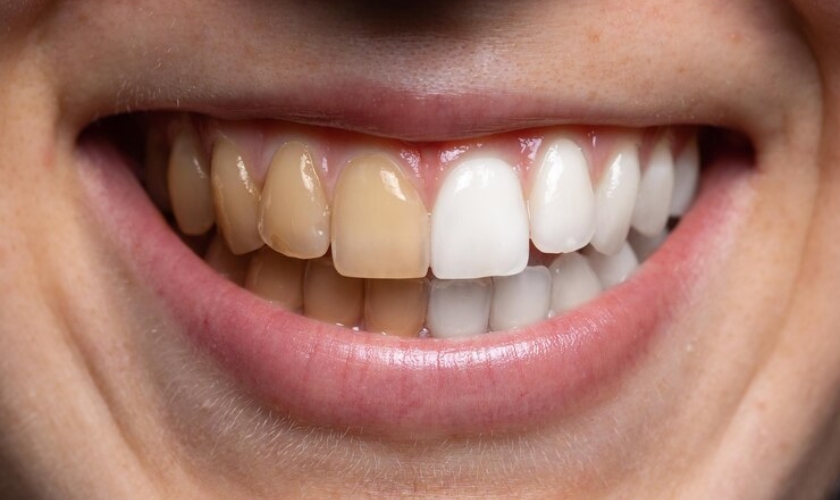
3 Types of Tooth Stains and How to Remove Them
A bright, confident smile can light up a room. Unfortunately, everyday habits and aging can take a toll on our pearly whites, leaving behind unsightly tooth stains. The good news is that, with the right knowledge and approach, you can combat these stains and achieve a healthier, more radiant smile.
Tooth stains are a common occurrence caused by various factors. The most frequent culprits include:
- Food and Drinks: Coffee, tea, red wine, dark berries, and highly pigmented foods can leave behind colored particles that cling to the tooth surface.
- Tobacco Use: Smoking and chewing tobacco stain teeth with nicotine and tar, leading to a yellow or brown discoloration.
- Poor Oral Hygiene: Inadequate brushing and flossing allows plaque and food particles to build up, creating a breeding ground for bacteria that stain teeth.
Addressing tooth stains isn’t just about aesthetics; it also reflects your commitment to oral health. Stains often indicate underlying issues like plaque buildup or tartar formation, which can contribute to gum disease and cavities. So, let’s delve deeper into the types of tooth stains and explore effective removal strategies.
Unveiling the Stain: Three Types of Discoloration
Tooth stains can be broadly classified into three categories based on their location within the tooth structure:
- Extrinsic Stains: These are the most common type, affecting the tooth’s outer enamel layer. They appear as surface discolorations caused by external factors like food, drinks, and tobacco use.
- Intrinsic Stains: These stains penetrate deeper into the tooth, reaching the dentin layer beneath the enamel. This type of stain can be caused by:
- Medications: Certain antibiotics like tetracycline can stain developing teeth in children.
- Trauma: Damage to a tooth can lead to internal bleeding, causing discoloration.
- Fluorosis: Excessive fluoride exposure during childhood can lead to white mottling on the teeth.
- Age-Related Stains: As we age, the enamel naturally thins, allowing the yellowish dentin layer beneath to show through. This gradual darkening is a natural part of the aging process.
Conquering the Surface: Removing Extrinsic Stains
The good news is that extrinsic stains are generally the easiest to remove. Here are some practical tips:
- Brushing Basics: Brushing your teeth twice daily with fluoridated toothpaste is crucial for removing surface stains and preventing new ones from forming.
- Toothpaste Power: Consider using whitening toothpaste for an extra boost. These toothpastes contain mild abrasives that help scrub away surface stains.
- Strips and Solutions: Over-the-counter whitening strips and rinses can be effective for moderate extrinsic stains. These products typically contain hydrogen peroxide or carbamide peroxide, which gently bleach the surface stains.
Remember, consistency is key! Regular brushing, flossing, and proper oral hygiene practices go a long way in maintaining a stain-free smile.
Intrinsic Stains: A Deeper Challenge
Removing intrinsic stains is more challenging as they reside deep within the tooth structure. While at-home methods might have minimal impact, professional solutions offer better results.
- Professional Teeth Whitening: In-office teeth whitening treatments performed by a dentist utilize concentrated bleaching agents to lighten intrinsic stains. These treatments are highly effective but may require multiple sessions.
- Veneers and Crowns: In severe cases, dentists may recommend veneers or crowns. These are thin shells of porcelain or composite material bonded to the front surface of the tooth, effectively masking the discoloration.
Embracing Age: Preventing and Minimizing Age-Related Stains
While the age-related stain is inevitable, certain lifestyle changes can help slow down the process and minimize its impact:
- Diet Adjustments: Limit your intake of stain-causing foods and beverages like coffee, tea, and red wine. Opt for water throughout the day to rinse away particles that can stain your teeth.
- Regular Dental Cleanings: Schedule regular dental cleanings with your dentist. Professional cleaning removes plaque and tartar buildup, reducing stain formation and keeping your teeth brighter.
Natural Remedies: A DIY Approach (with Caution)
Several natural remedies claim to whiten teeth, but their effectiveness varies. Here are a few with some important considerations:
- Baking Soda: A paste made with baking soda and water can be used for gentle stain removal. However, be cautious, as using it too frequently can erode tooth enamel.
- Hydrogen Peroxide: A diluted solution of hydrogen peroxide can be used as a mouthwash. However, prolonged use can irritate gums.
Remember to always consult your dentist before trying any home remedies for tooth whitening. They can advise you on the safest and most effective approach for your specific needs.
Tooth stains can be a source of self-consciousness, but understanding their types and knowing how to address them can help you maintain a bright and confident smile. By implementing good oral hygiene practices, utilizing home remedies, and seeking professional treatments when necessary, you can effectively manage and prevent tooth stains. Remember, a healthy smile is not just about aesthetics—it’s also a vital part of your overall well-being. Take action today to keep your teeth looking their best!
 3 Types of Tooth Stains and How to Remove Them
A bright, confident smile can light up a room. Unfortunately, everyday habits and aging can take a toll on our pearly whites, leaving behind unsightly tooth stains. The good news is that, with the right knowledge and approach, you can combat these stains and achieve a healthier, more radiant smile.
Tooth stains are a common occurrence caused by various factors. The most frequent culprits include:
3 Types of Tooth Stains and How to Remove Them
A bright, confident smile can light up a room. Unfortunately, everyday habits and aging can take a toll on our pearly whites, leaving behind unsightly tooth stains. The good news is that, with the right knowledge and approach, you can combat these stains and achieve a healthier, more radiant smile.
Tooth stains are a common occurrence caused by various factors. The most frequent culprits include: